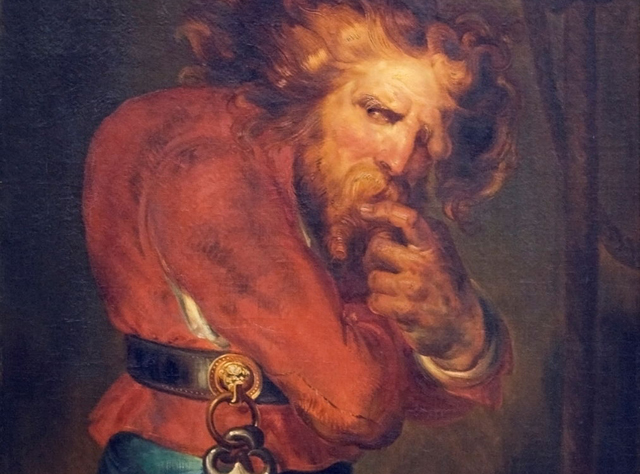
The city of Paris, France has many things that distinguish it among the great cities of the world. The most noteworthy of it’s features would be the iconic and varied architecture of the city, ranging from medieval to modern. Though there are many landmarks that bring tourists from all over the world to Paris, there is no doubt that many Parisians consider the heart of their beautiful city to be the Cathedral of Notre Dame. Constructed over an 180 year period and completed in 1345, Notre Dame is widely considered to be the greatest medieval gothic structure ever created. Known for it’s iconic twin tower façade, it’s extraordinary stained glass windows, and the far reaching tone of it’s massive bells, the Notre Dame Cathedral is a source of pride for the city of Paris. But it may surprise many that Notre Dame has had to face destruction many times throughout it’s nearly millennia long history. One of those times occurred in the post revolution France, after the long and straining Napoleonic Wars. The city of Paris had long neglected it’s jewel of the city and Notre Dame had been left to rot and fall apart. But, popular French author Victor Hugo wanted to change the minds of the apathetic Parisians and help them remember what Notre Dame meant to the city. He set about writing a new epic novel centered around the Cathedral and the people of Paris, with the hope that it would remind people why it was important to have structures like it preserved. The eventual novel, Notre Dame de Paris, was published in 1831, and it had the intended effect. Hugo’s novel was immensely popular and it led to a restoration effort by the city to bring Notre Dame back to it’s former glory. And while we have the novel of Victor Hugo’s to thank for helping Notre Dame survive a few more centuries, it also gave us some of literature’s most fascinating and unique characters as well.
The novel of course is referred to more by it’s English title, The Hunchback of Notre Dame, and that’s because it’s most memorable character is the titular hunchback; named Quasimodo. It’s said that when Hugo visited the crumbling Cathedral one day, he found carved in a stone on one of the towers a single word; Destiny. From that mysterious, unknown message, Victor Hugo began to speculate who might have carved such a word, and what it might have meant. Thus, he devised up the image of a deformed bell ringer who lived in the walls of the Cathedral itself. The actual novel focuses on a number of characters, primarily the gypsy Esmeralda and the villainous Claude Frollo, a zealous agent of the Church. Quasimodo actually has something of a minor presence in the book as a whole, but he is nonetheless pivotal to the story, and that’s why he’s become the icon on which the novel is mostly remembered for. He’s also one of the reasons why the novel has become a popular source of adaptation in many different mediums, including film. The Hunchback of Notre Dame has enjoyed many different film adaptations spanning the whole history of cinema, and the role of Quasimodo has been coveted by some of the most daring of performers. For one thing, Quasimodo is a challenging role to undertake. Portraying the deformed bell ringer requires a deep amount of soulfulness. It can be very easy to go too over the top with the character and portray him in a cringy, exploitative way. There is a fine line that must be walked in order to make Quasimodo feel like a genuine human being with a good soul like he is in the novel, and not the monster that he looks like on the outside. The more subtlety the better, and as seen in his many different screen appearances, it usually comes down to the talents of the actor to give Quasimodo the sincerity that he needs. What follows are some of Quasimodo’s most noteworthy appearances on the big and small screens, and as you’ll see, they include some performances that are iconic, as well as other that are notorious.
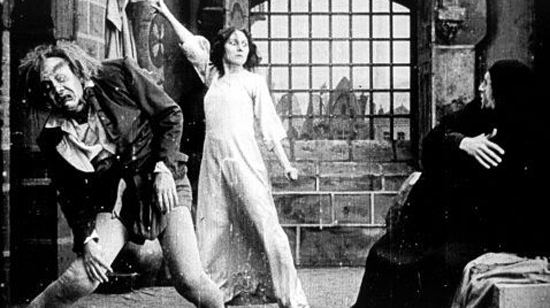
HENRY KRAUSS from THE HUNCHBACK OF NOTRE DAME (1911)
Even when cinema was in its infancy, Victor Hugo’s novel was seen as an ideal source for adaptation. Naturally, the French were the first to commit the story of Quasimodo to film. Though there was also an earlier adaptation from 1905, this 1911 version is the one that survives to this day. Like many films of the period, it’s limited in what it can bring to the screen, and the same can be said about Quasimodo’s part within the film. The 30 minute long movie is mostly centered around Esmeralda, and her persecution by the church, especially from the pious Frollo, who covets her for himself. Quasimodo only factors in at the end of the movie, much like he does in the novel, acting as a somewhat unexpected guardian for Esmeralda. The portrayal of Quasimodo by Henry Krauss is pretty limited, with the actor capturing the character as a lumbering creature that is more attack dog than man. Some have said that the portrayal almost takes on a Frankenstein’s monster characteristics. It’s certainly not the most sympathetic of portrayals of Quasimodo, but it’s also as much as you would expect in an early cinema retelling of the novel. All the acting from the performers is broad and dramatic, so Krauss’ Quasimodo would be too. And with the exaggerated, monster like mask that the actor has on, it’s easy to see how Quasimodo largely entered into the imagination of film-goers as something of a monster. Not much sympathy given to the character here, but at the same time, he does act as the deliverer of justice like he does in the novel. It’s a limited portrayal, but it would lead to many more who would thankfully explore the character more deeply in the year ahead.
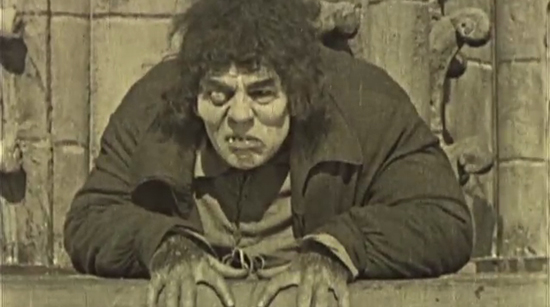
LON CHANEY from THE HUNCHBACK OF NOTRE DAME (1923)
Leave it to the “Man of a Thousand Faces” to take his own shot at portraying the iconic hunchback. This version of Hunchback proved so popular in fact, that it actually turned Chaney into a full-fledged movie star, and helped to lead to his roles as the Wolf Man and the Phantom of the Opera years later. Though Chaney does still lean into the monstrous side of the character, with his exaggerated and brooding performance, the movie does devote a bit more screen time to the character than he had seen before. With more substantial budgets and better filmmaking tools, filmmakers were able to better capture the grandeur of Hugo’s novel, and it allowed for more screen time for Quasimodo in the story. One moment that does get more focus in this version is the public lashing scene, where Quasimodo is tied down on a platform and pelted with garbage by the jeering public. It’s a pivotal moment from the books because it bonds Quasimodo and Esmeralda, after she shows compassion for the tortured being. Chaney portrays this moment very well and with tenderness, in stark contrast with the outward appearance that he has in the film. Lon Chaney had the reputation of applying his own groundbreaking prosthetic make-up, and his version of Quasimodo is definitely other-worldy, if a bit over the top. How he manages to perform underneath that mask of grotesquery is amazing, but it’s what he was best known for throughout his career. What his version did more than anything was to elevate Quasimodo as a part of the overall story, and that in itself would influence most of the adaptations that followed. If your movie is called The Hunchback of Notre Dame, it’s best that you know who your star attraction is, and Lon Chaney is one of the ones most responsible for turning Quasimodo into a screen icon.

CHARLES LAUGHTON from THE HUNCHBACK OF NOTRE DAME (1939)
If Lon Chaney was the one who popularized Quasimodo on the big screen, Charles Laughton would be the one that gave him respectability. In this classic 1939 Hollywood adaptation, we hear Quasimodo speak for the first time. Granted, he is incapable of saying much; the ringing of the Cathedral bells have left him deaf and he was never afforded much of an education other than what his caretaker, Frollo, had given him. But when he does, there is a great deal of compassion in his voice. It’s clear that Laughton wanted to find the humanity in the character of Quasimodo, and not just portray him as some creature. As a result, we get what many consider to be the greatest portrayal of the character ever put on screen. Laughton had built a reputation of playing some of history’s most noteworthy figures, including winning an Oscar for his Henry VIII in the Alexander Korda production of The Private Life of Henry VIII (1933). And while he had been a bit of a chameleon in the many different roles he portrayed, he never disappeared into a role quite like he did for Quasimodo. The look that he created for the character would also prove to be influential, with softer features that that of Chaney’s grotesque version. His rotund physique also would define the character, giving Quasimodo a less threatening outward appearance. And even though Quasimodo is mentally stunted in many ways, Laughton does give him soulful reflection that shows that Quasimodo is indeed compassionate at heart, and aware of his own moral compass. He even turns poetic in some of his reflections. As a result, Laughton really captures the aspect of the tragedy behind the character, that despite his good heart and his drive to do the right things, he will never be able to be accepted by the society at large, just because of the way he looks. Only Esmeralda (wonderfully played by Maureen O’Hara) sees the good soul within. It’s one of the greatest performances in one of the greatest movies ever made, and a groundbreaking one for Quasimodo as a cinematic character.
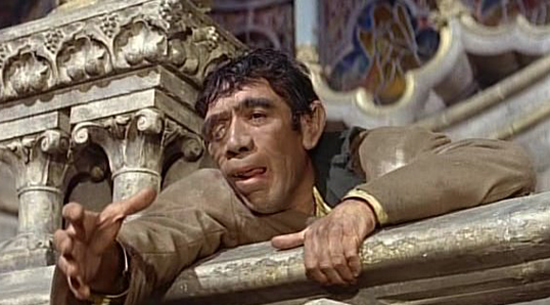
ANTHONY QUINN from THE HUNCHBACK OF NOTRE DAME (1956)
This widescreen epic retelling may have much of the grandeur of the 1939 version, but none of it’s subtlety. The Italian-French co-production is a flashy technicolor spectacle that features Anthony Quinn in the title role. Quinn was an actor fond of disappearing into a role, though he often wished to do it on his terms. And for the role of Quasimodo, he made the choice to portray the character his way. This involved him foregoing a prosthetic hump on his back like Chaney and Laughton had used, and instead he created the effect of a hunchback by changing his own physical gait and posture. This unfortunately has the effect of both not working as well as he thinks it does and also coming across as a bit insensitive to people with real physical difficulties. The reason why past screen Quasimodos have opted to create a fake hunch on their backs was because it would genuinely affect the posture of their performance, allowing them to more effectively maintain the performance throughout. Anthony Quinn’s non-hunch performance has the unintended effect of coming and going throughout the film, making the performance inconsistent. Not only that, but Quinn’s mumbly performance has none of the soul of Laughton’s subtle portrayal, so it just feels like the actor is mimicking the handicap just to show off some range. It’s exactly the wrong way of portraying the character. The movie around him is not much better either, turning the story into a brightly colored melodrama. Anthony Quinn has done much better work than this, and has disappeared into roles much more effectively. But when your Hunchback doesn’t even consistently have a hunch in his back, it’s a sign that he made the wrong choices in how he would tackle this kind of character.

ANTHONY HOPKINS from THE HUNCHBACK OF NOTRE DAME (TV MOVIE) (1982)
One of the more impressive portrayals of the character can be found in this surprisingly well crafted television adaptation. Anthony Hopkins, better known at that time for his heralded work on the stage, takes on the role of Quasimodo with the same kind of reverence that Charles Laughton showed 40 years prior. His version of Quasimodo certainly looks more ragged and deformed, but there is compassion behind his portrayal. And this version definitely leans heavily in the tragic figure category. The portrayal definitely fits the tone of this version of the story, which is surprisingly gritty for a television production. In many ways, this version of The Hunchback of Notre Dame may be the closest to Hugo’s original novel in terms of tone. It portrays the City of Paris as this wild, medieval place, with the Cathedral as it’s centerpiece. Like in the book, the city becomes character in itself, covering societies both high and low, from the palace of the king to the ratholes of the sewers. Past versions of Hunchback largely steered away from the darker elements of the story, but this version dives right in, and shows us the Paris that Victor Hugo envisioned. Anthony Hopkins, as always, delivers a performance that matches that needed darker tone, without losing the endearing elements that keeps Quasimodo sympathetic. It’s fitting that even in this version that creates a more broader and harsh tapestry, that Quasimodo is not overlooked, and is given life by yet another one of the greatest actors who ever lived. It’s also a version of the story and the character that sadly doesn’t translate into too many other versions, as it’s often the case that in order to get around some of Victor Hugo’s more pointed societal critiques, namely towards the church establishment itself, that many adaptations lack some of the story’s bite.
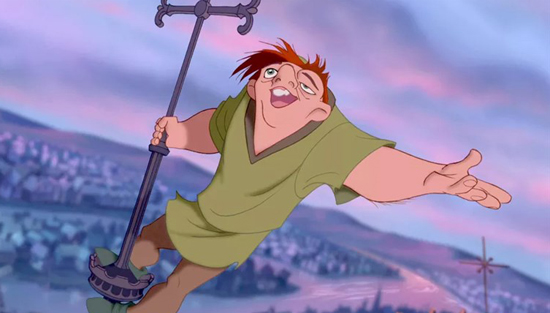
TOM HULCE from DISNEY’S THE HUNCHBACK OF NOTRE DAME (1996)
Apart from Charles Laughton’s iconic version, this is the portrayal of Quasimodo that likely first comes to mind. Walt Disney Animation, in the midst of their Renaissance Era, made the controversial decision to take Victor Hugo’s classic story and give it a G-Rated spin, with a happy ending no less. And while purists of the original story will have much to complain about, there is a lot to admire in Disney’s attempt. It’s beautifully, and even hauntingly animated, and it features one of the best musical scores of any Disney film (yes, they turned it into a musical too). In addition, it creates one of the most unique versions of Quasimodo ever put on screen. The movie downplays many of Quasimodo’s handicaps (he speaks coherently, and even sings) and his deformity is softened to the point where he becomes more cute than grotesque. But, Disney does a good job of capturing his social anxiety that has developed over years of isolation. And the themes of prejudice, persecution, and overcoming tyranny are still maintained from Hugo’s original work, and most interestingly, this version sees the story unfold almost solely through Quasimodo’s eyes. He is more central to the story here than any version before, and it gives us far more insight into his character. A lot of credit goes to actor Tom Hulce for his soulful portrayal, although some of his dialogue may fall a bit too heavily in the cutesy, Disney-fied territory. Hulce still manages to show a dynamic range of emotions through the character, and probably delivers the most epic reading of the line “Sanctuary!!” in history. For many recent generations, this has been the entry point for a lot of children to learn about Victor Hugo’s original story, the idea of not judging a book by it’s cover, as well as the importance of the Notre Dame Cathedral itself. While I’m sure this movie version may have appalled Victor Hugo himself if he were to see it, it nevertheless is an impressive attempt that is more mature than the average animated film and features one of the more interesting Quasimodos we’ve seen yet on the big screen.
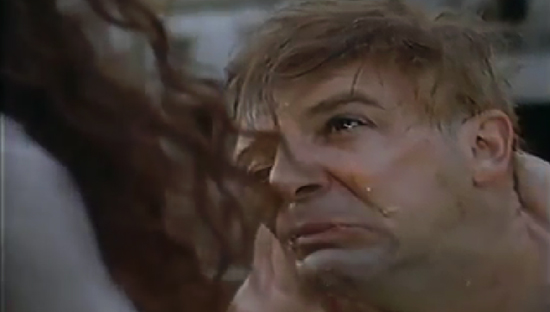
MANDY PATINKIN from THE HUNCHBACK (TV MOVIE) (1997)
We have another version, made for TV, that does put Quasimodo more at the center of the story. This one, unfortunately has none of the depth of character of Disney’s version, nor the subtlety and grit of Anthony Hopkin’s TV version. It was a movie that clearly piggy-backed on the success of Disney’s version and was released only a year later. Interesting enough, Mandy Patinkin was one of the actors who auditioned for Disney’s Quasimodo, but did not get it (apparently due to a disastrous audition). It’s probably a good thing in the end because his portrayal of Quasimodo here is so bland and basic. He acts through heavy prosthetics, but doesn’t have the dynamic screen presence of Lon Chaney to make his performance work through the make-up. Instead, he just looks like he’s making weird faces throughout the movie. The whole thing looks like a rushed production, despite having some solid talent on board; apart from Patinkin, the movie also has Selma Hayek as Esmeralda and Richard Harris as Frollo. It’s says a lot that a version of this story looks so much more low rent than another TV version that was made 15 years prior. Exactly how hard was it to get a better budget for this movie. Even still, it comes down to how well the actors can work through the shortcomings, and though performers like Mandy Patinkin have shown they can be very good in many different things, it does not work out as well when they are given so little to work with. It’s a mostly boring and forgettable TV feature that only stands out mostly in how much it falls short of past versions of the story put to screen.
What I think is very interesting about the character of Quasimodo in his evolution on the big screen over the years is how he has gone from an oddity within the fabric of a larger narrative, to someone who commands the story completely. Each version of Quasimodo brings him more central to the story, to where he goes from a unruly creature in the silent movie version, to being the primary protagonist in an animated feature. It’s a testament to the filmmakers and actors over the years who have tried so hard to find the humanity in the character that we have grown to empathize with him and even identify with him in many ways. Charles Laughton’s groundbreaking version certainly laid the groundwork for giving the character new purpose, and Disney (despite straying very heavily from Victor Hugo’s original intent) has fully turned Quasimodo into not just an empathetic character, but also a hero. It’s surprising that not many more adaptations have come in recent years. It has been floated that Disney will likely do a live action remake of their animated film in the coming years, and rumor is that Idris Elba is looking at making a modern day re-imagining of the story with Netflix. Despite all the many different interpretations of the story, there is one thing that has left a lasting legacy from this book, and that’s the reverence it gave to the Notre Dame Cathedral itself. The Cathedral almost becomes this maternal presence in the story, giving Quasimodo a home and Esmeralda a sanctuary, and it’s helped to keep the real structure cherished in the hearts of people the world over. When the Cathedral was nearly lost in a fire two years ago, it hit close to home even to people who have never been to Paris, and that is likely due to how much the story of The Hunchback of Notre Dame has permeated the culture. Despite the cryptic message found by Victor Hugo all those years ago, there never was a bell ringer named Quasimodo, but there has always been a Notre Dame, and that in turn has given us an attachment to him as a character. Quasimodo has become just as much of an icon as the Cathedral he called home and it’s been a pleasing thing to see him become treated more humanely with every new interpretation.